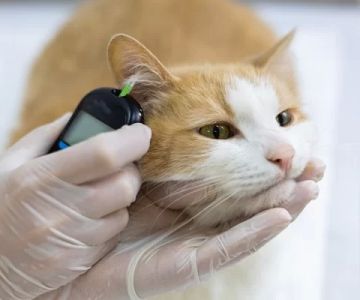How to Handle Cat Behavior Problems: A Comprehensive Guide
- 1. Understanding Cat Behavior Problems
- 2. Common Cat Behavior Issues
- 3. Dealing with Aggressive Behavior in Cats
- 4. Solving Litter Box Problems
- 5. Helping Cats with Anxiety and Stress
- 6. When to Seek Professional Help for Cat Behavior
As cat owners, understanding your feline companion’s behavior can be both rewarding and challenging. Cats are known for their independent nature, but when they start displaying unusual or undesirable behavior, it can be frustrating. Whether your cat is scratching the furniture, ignoring the litter box, or showing signs of aggression, it's essential to understand the reasons behind these behaviors to address them effectively.
This guide will help you explore common cat behavior problems and provide practical tips for managing them, ensuring that you and your cat can live harmoniously. By addressing these issues early, you can improve your cat's well-being and create a better home environment for everyone.
Common Cat Behavior Issues
Cats, just like people, have their quirks and idiosyncrasies. However, some behaviors can become problematic if not addressed. Here are some common cat behavior problems:
- Scratching: Scratching is a natural instinct for cats, but when it becomes excessive or destructive, it can be a nuisance. Cats scratch to mark their territory and to keep their claws sharp. Providing scratching posts and using pheromone sprays can help redirect this behavior.
- Excessive Meowing: While meowing is a way for cats to communicate, excessive meowing can be a sign of boredom, hunger, or even illness. Ensure your cat has a stimulating environment and a consistent feeding schedule to reduce this behavior.
- Urine Marking: Cats may spray urine to mark their territory, especially in multi-cat households. Neutering or spaying your cat, as well as providing enough litter boxes, can help minimize this issue.
By identifying and addressing these common issues, you can help prevent them from becoming more significant problems.
Dealing with Aggressive Behavior in Cats
Aggression in cats is one of the more challenging behaviors to manage. Whether it’s aggression towards people or other animals, it can cause stress and fear. There are several reasons a cat may display aggression, such as territorial disputes, fear, pain, or even overstimulation. Understanding the cause of aggression is the first step in resolving it.
- Understand the Triggers: Pay close attention to your cat's body language and the situations that cause aggression. Cats may become agitated due to sudden movements, loud noises, or unfamiliar people or animals.
- Provide a Safe Space: If your cat is aggressive, ensure they have a safe, quiet space where they can retreat and feel secure. Reducing stress and providing shelter can often help calm an aggressive cat.
- Use Positive Reinforcement: Reward calm behavior with treats or affection. Gradually desensitize your cat to the triggers of aggression through slow, positive exposure.
If your cat's aggression persists or becomes dangerous, seeking advice from a professional animal behaviorist may be necessary.
Solving Litter Box Problems
One of the most common cat behavior issues is inappropriate elimination, particularly not using the litter box. Cats are generally very clean animals, so when they stop using the litter box, it can be a sign of underlying issues. There are several steps you can take to resolve litter box problems:
- Ensure Cleanliness: Cats are fastidious about their litter box, so make sure it's cleaned regularly. Cats may avoid a dirty box and prefer to eliminate elsewhere.
- Provide Multiple Boxes: If you have more than one cat, make sure there are enough litter boxes. The rule of thumb is one box per cat, plus one additional box.
- Address Health Issues: Sometimes, a cat may stop using the litter box due to a urinary tract infection or other medical condition. A visit to the vet is necessary if health problems are suspected.
By addressing these factors, you can encourage your cat to use the litter box properly again.
Helping Cats with Anxiety and Stress
Many cat behavior problems arise from anxiety and stress. Cats are sensitive creatures, and changes in their environment or routine can trigger anxiety. Common signs of stress in cats include hiding, excessive grooming, or vocalization. Here’s how you can help your anxious cat:
- Provide a Routine: Cats thrive on routine, so try to feed and play with your cat at the same time every day. Consistency can help reduce stress.
- Use Calming Products: Consider using pheromone diffusers, sprays, or calming collars to help soothe your cat. These products mimic the natural calming pheromones that cats release.
- Provide a Safe Environment: Create a peaceful environment for your cat by reducing loud noises and providing quiet spaces where they can retreat if needed.
With patience and the right strategies, you can help alleviate your cat's anxiety and prevent stress-related behavior issues.
When to Seek Professional Help for Cat Behavior
While many cat behavior problems can be resolved with patience and training, some situations may require professional assistance. If your cat's behavior is significantly affecting their quality of life or your own, it's time to seek help from a veterinarian or animal behaviorist.
- Persistent Aggression: If aggression is severe and ongoing, it may be necessary to consult a professional.
- Behavioral Issues Affecting Health: If your cat’s behavior is linked to health problems or if they are harming themselves, a vet visit is essential.
- Lack of Improvement: If your attempts to resolve the issue at home have not been successful, professional intervention can offer targeted solutions.
Professionals can help assess the situation and create a customized plan to address the behavior effectively, ensuring a happy and healthy relationship with your cat.









